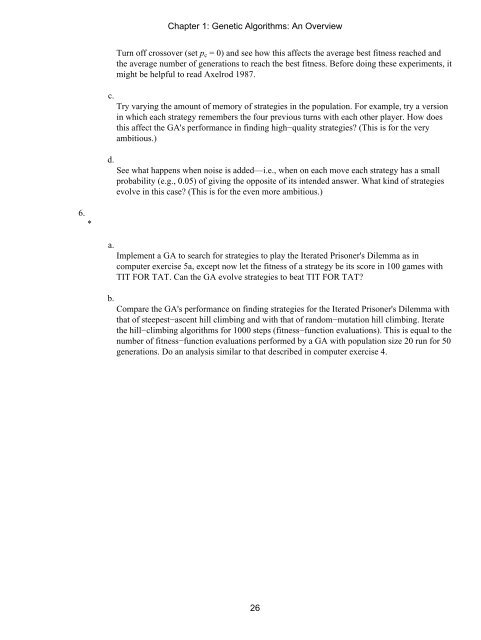An Introduction to Genetic Algorithms - Boente
An Introduction to Genetic Algorithms - Boente
An Introduction to Genetic Algorithms - Boente
Create successful ePaper yourself
Turn your PDF publications into a flip-book with our unique Google optimized e-Paper software.
6.<br />
*<br />
c.<br />
d.<br />
a.<br />
b.<br />
Chapter 1: <strong>Genetic</strong> <strong>Algorithms</strong>: <strong>An</strong> Overview<br />
Turn off crossover (set pc = 0) and see how this affects the average best fitness reached and<br />
the average number of generations <strong>to</strong> reach the best fitness. Before doing these experiments, it<br />
might be helpful <strong>to</strong> read Axelrod 1987.<br />
Try varying the amount of memory of strategies in the population. For example, try a version<br />
in which each strategy remembers the four previous turns with each other player. How does<br />
this affect the GA's performance in finding high−quality strategies? (This is for the very<br />
ambitious.)<br />
See what happens when noise is added—i.e., when on each move each strategy has a small<br />
probability (e.g., 0.05) of giving the opposite of its intended answer. What kind of strategies<br />
evolve in this case? (This is for the even more ambitious.)<br />
Implement a GA <strong>to</strong> search for strategies <strong>to</strong> play the Iterated Prisoner's Dilemma as in<br />
computer exercise 5a, except now let the fitness of a strategy be its score in 100 games with<br />
TIT FOR TAT. Can the GA evolve strategies <strong>to</strong> beat TIT FOR TAT?<br />
Compare the GA's performance on finding strategies for the Iterated Prisoner's Dilemma with<br />
that of steepest−ascent hill climbing and with that of random−mutation hill climbing. Iterate<br />
the hill−climbing algorithms for 1000 steps (fitness−function evaluations). This is equal <strong>to</strong> the<br />
number of fitness−function evaluations performed by a GA with population size 20 run for 50<br />
generations. Do an analysis similar <strong>to</strong> that described in computer exercise 4.<br />
26






